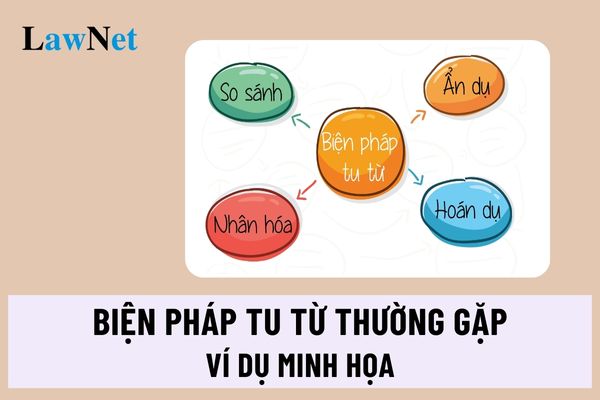Some Common Rhetorical Devices and Illustrative Examples for Students in Vietnam
Some Common Rhetorical Devices and Illustrative Examples for Students in Vietnam
Common rhetorical devices and illustrative examples include:
(1). Simile:
Concept: A simile is a comparison between two or more objects or events that share similarities to highlight the characteristics of the compared object.
Example:
Cô ấy đẹp như một đóa hoa hồng.
Cậu bé ấy chạy nhanh như chớp.
(2). Personification:
Concept: Attributing human traits, emotions, or activities to objects, plants, or animals.
Example:
Cây bàng già đứng trầm ngâm bên đường.
Mặt trời mỉm cười rạng rỡ
(3). Metaphor:
Concept: Replacing a word or phrase with another word or phrase that bears resemblance to create a vivid image.
Example:
"Máu lửa tuổi trẻ"
"Những cánh buồm giương to"
(4). Metonymy:
Concept: Using a word or phrase that represents a part, feature, or concept to refer to the thing meant.
Example:
"Cái răng, cái tóc là góc con người"
"Áo xanh" chỉ những người công nhân
(5). Hyperbole:
Concept: Exaggerating objects or phenomena to emphasize a point.
Example:
Nước sông dâng lên cuồn cuộn như muốn tràn bờ.
Mưa rơi như trút nước.
(6). Euphemism:
Concept: Using gentle or indirect expressions to avoid causing feelings of vulgarity or sadness.
Example:
Quy tiên (thay cho chết)
Bạn ấy dạo này không được chăm chỉ lắm (thay cho bạn ấy dạo này lười lắm)
(7). Repetition:
Concept: Repeating a word or phrase multiple times to emphasize and create rhythm.
Example:
"Dòng sông, dòng sông ơi!"
"Học, học nữa, học mãi"
(8). Pun:
Concept: Using homophones, multiple meanings, or similar grammatical structures to create a surprising or humorous effect.
Example:
Tre già măng mọc
Ăn quả nhớ kẻ trồng cây
(9). Enumeration:
Concept: Listing multiple words or phrases of the same type to emphasize or clarify an idea.
Example:
"Trời xanh, biển rộng, cát trắng, nắng vàng"
...
Moreover, the effects of rhetorical devices are as follows:
- Enhancing visual and emotional imagery: Helps the reader to vividly imagine objects and phenomena.
- Emphasizing ideas: Highlights the main, important ideas in the text.
- Creating rhythm: Brings harmony and balance to the text.
- Making an impression: Attracts the reader's attention.
Note: The above content is for reference purposes only.

Some Common Rhetorical Devices and Illustrative Examples for Students in Vietnam (Image from the Internet)
Which rhetorical devices do primary school students in Vietnam learn?
Based on clause 2, Section 4 of the Literature Curriculum issued together with Circular 32/2018/TT-BGDDT:
2. Attainable Requirements for Specific Competencies
2.1. Required Competencies in Primary Education
a) Language competency
...
b) Literary competency
Distinguish between narrative and poetic texts (excerpts, prose segments and verses); identify the content of the text and the author's attitude and emotions; initially understand the effect of some formal elements of literary texts (words, characters, plots, verses, comparisons, personifications). Know how to imagine and express literary expression in writing and speaking.
For students in grades 1 and 2: Identify what the text is about and the characters in the stories; identify the rhyme in poetry; differentiate between stories and poems.
For students in grades 3, 4, and 5: Know how to read expressively literary texts; recount and summarize the main content of the story, poem; comment on the characters, events, and the writer's attitude and emotions in the text; identify the time and place, some types of rhyme, rhythm, words, beautiful and unique images and the effects of rhetorical devices like personification, comparison. Understand the lesson or meaning drawn from the text. Write stories, descriptive paragraphs expressing emotions and imaginative abilities.
Students in grades 3, 4, and 5 will learn and recognize the effects of rhetorical devices such as personification and comparison.
Which rhetorical devices do lower secondary school students in Vietnam learn?
Based on clause 2, Section 4 of the Literature Curriculum issued together with Circular 32/2018/TT-BGDDT, lower secondary school students are required to recognize and analyze rhetorical devices as follows:
In grades 6 and 7: Recognize and analyze the effects of some formal elements and artistic devices related to the characteristics of each literary genre, including rhetorical devices like metaphor, metonymy, hyperbole, and euphemism;
In grades 8 and 9: Recognize and analyze the effects of some formal elements and artistic devices in each literary genre, including rhetorical devices like repetition, pun, irony, and paradox.

